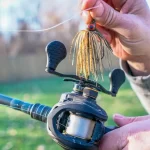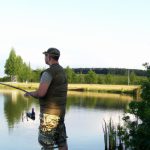Introduction to Surf Fishing
Surf fishing is a popular form of angling that involves casting your fishing line into the ocean from the shoreline. Unlike traditional fishing, surf fishing requires you to contend with the constant motion of the waves and the unpredictable nature of the surf zone. It offers a unique opportunity to catch a variety of fish species, including striped bass, red drum, flounder, and many others.
Essential Gear for Surf Fishing
Before you venture into the world of surf fishing, it’s essential to have the right gear. Here are some key items you’ll need:
Fishing Rod and Reel
Invest in a sturdy, medium to heavy-action fishing rod that is at least 9 feet long to allow for longer casts. Pair it with a saltwater spinning reel that can withstand the corrosive effects of saltwater.
Fishing Line and Leader
Choose a quality monofilament or braided fishing line with a test strength suitable for the target species. Attach a fluorocarbon leader to the mainline to provide added strength and stealth.
Tackle and Terminal Gear
Carry an assortment of hooks, sinkers, swivels, and rigs to adapt to different fishing conditions. Use circle hooks for catch-and-release fishing to minimize harm to the fish.
Bait and Lures
Stock up on live bait such as sand fleas, shrimp, or bloodworms, as well as artificial lures like spoons, plugs, and soft plastic baits. Different fish species have different preferences, so experiment to see what works best.
Other Essential Items
Don’t forget to bring a tackle box, sunscreen, polarized sunglasses, a hat, a beach cart or backpack, a cooler with ice, and plenty of water and snacks for a comfortable and enjoyable surf fishing experience.
Selecting the Perfect Surf Fishing Spot
To increase your chances of success, it’s crucial to choose the right location for surf fishing. Consider the following factors when selecting a spot:
Structure and Currents
Look for areas with underwater structure such as sandbars, jetties, or rocky outcrops. These features create currents that attract fish and provide food sources.
Sand Conditions
Sandy beaches with gradual slopes are ideal for surf fishing, as they allow fish to come closer to the shore while offering a stable footing for anglers.
Local Knowledge and Research
Consult local anglers, fishing reports, or online resources to gather information about the best surf fishing spots in your area. Factors like time of year and seasonal fish migrations can significantly impact your fishing success.
Tides and Weather: Understanding Their Impact
Understanding tides and weather patterns is crucial in surf fishing. The rising and falling of tides affect fish behavior and their feeding patterns. Pay attention to the following:
High and Low Tides
During high tide, fish move closer to the shore, providing excellent opportunities for surf anglers. Low tide, on the other hand, exposes structures and can concentrate fish in deeper troughs or channels.
Weather Conditions
Favorable weather conditions, such as overcast skies, light winds, and low barometric pressure, can trigger increased fish activity. Rainfall can also create runoff, attracting fish seeking food.
Moon Phases
Some anglers believe that certain moon phases, such as the new moon or full moon, can influence fish behavior. Experiment and observe patterns to determine if moon phases impact your fishing success.
Bait and Lures for Surf Fishing
Choosing the right bait or lure is crucial for enticing fish to bite. Consider the following options:
Live Bait
Live bait can be highly effective for surf fishing. Use local baitfish, sand fleas, shrimp, or bloodworms to target a variety of fish species.
Artificial Lures
Artificial lures provide versatility and can imitate various prey items. Try spoons, plugs, soft plastic baits, or surface poppers to entice fish into striking.
Cut Bait and Fresh Fish
Cut bait, such as pieces of squid or fish, can attract larger predators. Fresh fish, caught or purchased, can also be used as bait for specific species.
Casting Techniques for Optimal Distance
To reach the prime fishing spots, you need to master casting techniques that maximize your casting distance. Follow these steps for an effective cast:
Grip and Stance
Hold the rod firmly with your dominant hand, keeping your thumb on top of the rod handle. Stand with your feet shoulder-width apart, facing the target area.
Backswing and Forward Cast
With a smooth and controlled motion, bring the rod tip back behind your shoulder. Then, swiftly move it forward, releasing the line at the right moment to achieve maximum distance.
Practice and Experiment
Practice your casting technique regularly to improve accuracy and distance. Experiment with different casting styles, such as overhead cast, sidearm cast, or pendulum cast, to adapt to various surf conditions.
Reading the Waves: Identifying Feeding Zones
Being able to read the waves and identify feeding zones is a crucial skill in surf fishing. Look for the following signs to locate areas where fish are likely to be present:
Wave Breaks and Troughs
Fish often gather in the areas where waves break, creating turbulence and dislodging food. Additionally, troughs or channels formed between sandbars can concentrate fish.
Color Changes in the Water
Notice any variations in water color, as they can indicate changes in
the underwater environment or the presence of baitfish. Darker patches may signify deeper areas where fish seek shelter or hunt for food.
Bird Activity
Keep an eye on the activity of seabirds, such as seagulls or pelicans. Birds diving into the water or hovering over a particular spot can indicate the presence of baitfish or predatory fish below.
Currents and Rips
Pay attention to the movement of water and any visible currents or rips. These areas create a natural conveyor belt for baitfish, attracting larger fish looking for an easy meal.
Patience and Persistence: Waiting for the Bite
Surf fishing requires patience and persistence. Here are some tips to enhance your chances of getting a bite:
Be Still and Quiet
Once you have cast your line, avoid unnecessary movement or noise that may startle fish. Find a comfortable spot and remain patient, allowing the fish to come to you.
Stay Alert
Maintain a watchful eye on your rod tip for any subtle movement or indication of a bite. Familiarize yourself with different types of bites, such as nibbles, taps, or strong pulls.
Vary Your Retrieve
If you’re using artificial lures, experiment with different retrieval techniques to mimic the movement of prey. Try steady retrieves, jerks, pauses, or a combination to entice fish to strike.
Keep Changing Tactics
If you haven’t had any bites for a while, don’t be afraid to switch bait, lures, or locations. Fish can be selective, so adapting your approach can increase your chances of success.
Fighting and Landing the Fish
Once you’ve hooked a fish, it’s important to handle the fight and landing process carefully. Follow these steps to increase your chances of successfully landing the fish:
Maintain Tension
Keep a steady pressure on the fish by keeping your rod tip up and maintaining tension on the line. Avoid jerking the rod excessively, as it can lead to a snapped line or a lost fish.
Tire the Fish
Allow the fish to tire itself out by using its own strength. Avoid rushing the process, especially with larger fish, as they can make powerful runs or sudden dives.
Use a Landing Net
When the fish is close to shore, use a landing net to secure it. Gently guide the fish into the net, being careful not to force it, as sudden movements can cause the hook to dislodge.
Handle with Care
If you plan to release the fish, handle it with wet hands or use a wet towel to minimize damage to its protective slime layer. Avoid squeezing or mishandling the fish, as it can harm them.
Safety Precautions for Surf Fishing
While surf fishing can be exciting, it’s essential to prioritize safety. Consider the following precautions to ensure a safe fishing experience:
Be Aware of Your Surroundings
Pay attention to the tide’s movement and avoid fishing in areas prone to strong currents or sudden waves. Stay vigilant and be cautious of incoming tides that can cut off your retreat.
Use Protective Footwear
Wear appropriate footwear with good traction to prevent slipping on wet rocks or uneven surfaces. Protect your feet from sharp objects such as shells, rocks, or fish spines.
Check Weather Forecasts
Before heading out, check the weather forecast for any potential storms, high winds, or dangerous conditions. Avoid fishing during extreme weather conditions for your safety.
Use Sun Protection
Apply sunscreen generously to protect your skin from harmful UV rays. Wear a hat, sunglasses, and lightweight clothing to shield yourself from the sun’s intensity.
Etiquette and Environmental Responsibility
As responsible anglers, it’s important to practice good etiquette and protect the environment. Follow these guidelines to minimize your impact on the ecosystem:
Pack Out Your Trash
Dispose of your trash properly and leave the fishing spot cleaner than you found it. Carry a trash bag and pick up any litter you encounter, including discarded fishing lines or plastic waste.
Respect Wildlife
Observe wildlife from a distance and avoid disturbing their natural habitat. Be mindful of nesting areas or sensitive ecosystems and avoid causing unnecessary harm to marine life.
Follow Fishing Regulations
Familiarize yourself with local fishing regulations, including size limits, bag limits, and any seasonal or species-specific restrictions. Respect these rules to ensure sustainable fishing practices.
Surf Fishing Tips and Tricks
To enhance your surf fishing experience, here are some additional tips and tricks to consider:
Time Your Fishing
Pay attention to the best times for surf fishing, which are often during the early morning or late evening when fish are most active. However, fish behavior can vary, so experiment with different times of the day.
Observe Nature’s Clues
Keep an eye out for signs of baitfish activity, such as jumping or splashing, as it can indicate the presence of predator fish nearby. Seals or dolphins feeding in an area can also be a good sign.
Stay Organized
Maintain a well-organized tackle box with different hooks, weights, and rigs for easy access. Keep your gear clean and well-maintained to ensure optimal performance.
Learn from Others
Join local fishing clubs, forums, or engage with experienced surf anglers to learn from their expertise. Sharing knowledge and experiences can significantly improve your fishing skills.
Conclusion
Surf fishing is an exhilarating way to connect with nature and enjoy the thrill of angling. By following the tips and techniques outlined in this guide, you’ll be well-prepared to embark on your surf fishing adventures. Remember to respect the environment, prioritize safety, and have fun exploring the vast possibilities that the shoreline has to offer.
Frequently Asked Questions (FAQs)
Q1. Do I need a fishing license for surf fishing?
A1. Fishing license requirements vary depending on your location. Check with the local fishing authorities to determine if a license is required and how to obtain one.
Q2. What types of fish can I catch while surf fishing?
A2. Surf fishing offers the opportunity to catch a wide range of species, including striped bass, red drum, flounder, bluefish, pompano, and many others. The specific fish available will depend on your location and the time of year.
Q3. How far should I cast my line when surf fishing?
A3. The distance you cast will depend on various factors such as the beach structure, target species, and prevailing conditions. Aim for the areas where the waves break or where the water is deeper to increase your chances of success.
Q4. Can I practice catch-and-release while surf fishing?
A4. Yes, catch-and-release is a common practice in surf fishing. Ensure you handle the fish with care and release them back into the water as quickly as possible to minimize stress and injury.
Q5. Are there any specific techniques for surf fishing with artificial lures? A5. Experiment with different retrieval techniques to imitate the movement of prey.


